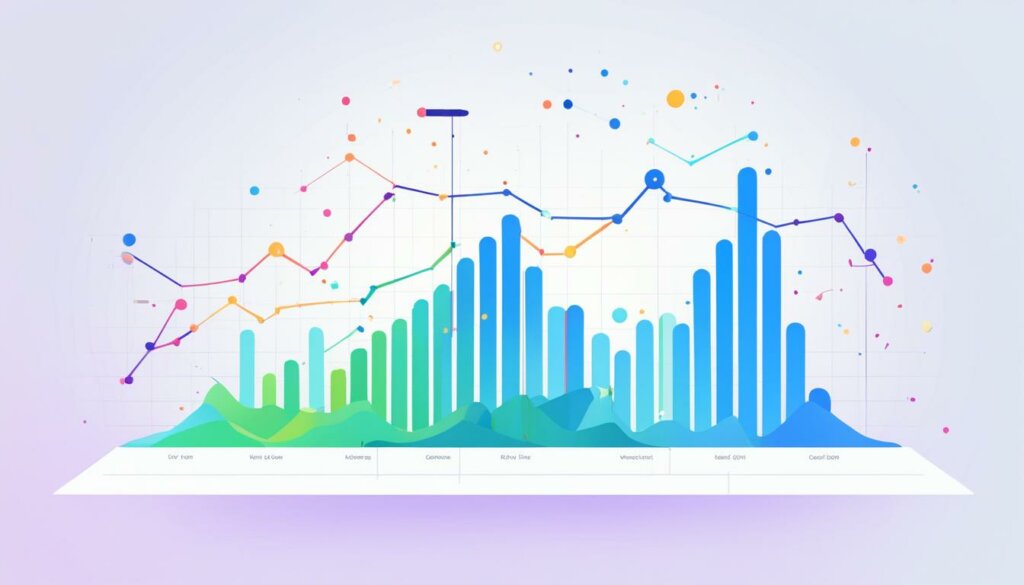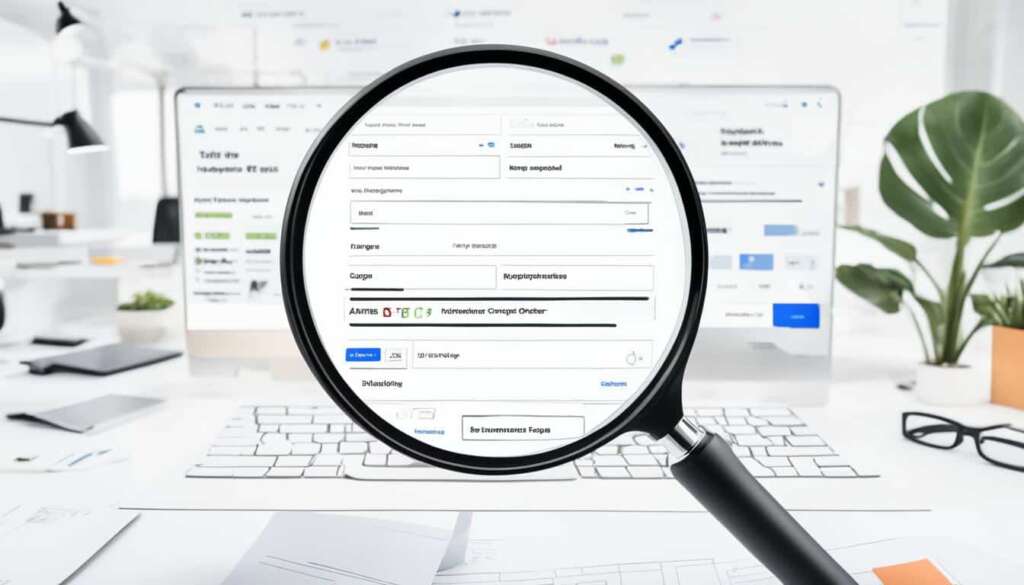Table of Contents
Are you looking to enhance your e-commerce website and drive revenue growth? Effective e-commerce website optimization is the key to achieving your online business goals. By strategically implementing various tools and strategies, you can improve your search engine optimization (SEO) efforts and boost your website’s visibility and organic traffic.
One of the fundamental aspects of e-commerce website optimization is keyword research. Understanding how your target customers search for products is crucial for creating relevant and targeted content. Keyword research tools like Google Keyword Planner and Semrush Keyword Magic Tool can help you discover valuable keyword suggestions, evaluate search volume and competition, and identify long-tail keywords that can give you a competitive edge.
By delving into search intent, search volume, and keyword difficulty, you can make informed decisions about the keywords you target. Long-tail keywords, although they may have lower search volume, can be advantageous for new or less-established websites as they are less competitive.
Conducting an Ecommerce Keyword Analysis and using tools like UberSuggest can provide valuable insights into popular search queries and topics for your e-commerce website. By organizing your keyword research and content architecture using tools like LucidChart, you can effectively structure your website and ensure your optimization efforts are maximized.
Additionally, analyzing the historical performance of your website and identifying any issues that require optimization can be achieved through tools like Wayback Machine. This analysis provides valuable insights that can be addressed through optimization techniques such as on-page SEO, technical SEO, content marketing, and link building.
Stay tuned as we delve deeper into specific strategies and tools for e-commerce website optimization, including implementing on-page SEO, optimizing product pages, analyzing competitors, enhancing user experience, and monitoring website performance. With a comprehensive approach to optimization, you can create a robust online business strategy that drives revenue growth and ensures a seamless user experience.
Implement On-Page SEO Optimization
On-page SEO is a fundamental aspect of optimizing your e-commerce website. It involves strategic implementation of various tactics and elements to improve your site’s visibility and search engine rankings. One key component of on-page SEO is the use of target keywords throughout your web pages. These keywords should be strategically incorporated into key areas such as page titles, headings, meta descriptions, body copy, and product descriptions.
For example, if your primary keyword is “women’s tennis rackets,” you would ensure that this keyword is included in each of these areas on the relevant page of your website. By doing so, you are providing search engines with clear signals about the content and relevance of your page.
Optimizing these elements of your website can greatly enhance its visibility and organic traffic. To streamline the process and maximize efficiency, you can leverage tools such as the Ecommerce Booster app. This app utilizes artificial intelligence to generate highly optimized meta and product descriptions, taking your on-page SEO efforts to the next level.
However, on-page SEO is not limited to individual page optimization. It extends to other critical factors such as website structure and hierarchy, technical SEO, content marketing, and link building. These aspects work in tandem to create a comprehensive optimization strategy that ensures your website is well-positioned for success.
Implementing a solid on-page SEO optimization strategy requires deep knowledge and expertise. It involves meticulous keyword research, compelling content creation, strategic link building, and user-friendly website design. By executing these strategies effectively, you can improve your website’s visibility, attract more targeted traffic, and ultimately drive conversions.
To learn more about how to optimize your e-commerce website and unlock its full potential, it is recommended to refer to a comprehensive guide that encompasses all the essential elements of on-page SEO and beyond.
Optimize Product Page
Optimizing your product pages is crucial for providing a seamless user experience and maximizing conversions. With the help of website optimization tools, you can monitor and gauge the performance of your eCommerce store, ensuring that it meets the expectations of your prospective customers. Let’s explore some essential tools and techniques to optimize your product pages.
1. On-Page SEO Audit with MOZ’s On-Page Grader
To enhance the visibility of your product pages, conducting an on-page SEO audit is crucial. MOZ’s On-Page Grader is an invaluable tool that evaluates your pages and provides suggestions for fixing any SEO errors. By implementing their recommendations, you can optimize your titles, headings, meta descriptions, and overall content to improve search engine rankings and attract organic traffic.
2. Mobile-Friendliness and Google AMP Pages
In today’s mobile-first world, ensuring mobile-friendliness is essential for eCommerce success. To enhance the mobile usability of your product pages, consider implementing Google AMP (Accelerated Mobile Pages). Additionally, tools such as Varvy’s mobile usability testing tool can help you identify and address any mobile optimization issues, providing a smooth user experience across various devices.
3. Optimizing Website Speed
Website speed is a critical factor for user satisfaction and conversions. Slow-loading pages can lead to higher bounce rates and cart abandonment. Tools like Pingdom, GTmetrix, and PageSpeed Insights can analyze your website’s speed and performance, providing actionable insights to optimize page load times. By compressing images, minifying code, and optimizing server response times, you can ensure a fast and seamless browsing experience for your prospective customers.
4. Responsive Design and Responsinator
A responsive design is crucial for delivering a consistent and user-friendly experience across different devices. Tools like Responsinator enable you to test and optimize your website’s responsiveness, ensuring that it adapts seamlessly to various screen sizes. By providing a visually appealing and intuitive interface, you can enhance user engagement and drive conversions.
5. Addressing Broken Links and SEO Issues
Broken links can negatively impact user experience and search engine rankings. Tools like Screaming Frog and Broken Link Checker can help you identify and fix broken links on your product pages, ensuring a seamless browsing experience. Additionally, these tools can also identify other SEO issues like duplicate content, missing meta tags, or indexing problems, allowing you to proactively address them.
6. Enhancing User Experience with Heatmaps
Understanding user behavior is crucial for optimizing your product pages. Tools like Crazy Egg provide heatmaps that visualize user interactions, allowing you to identify engagement patterns and optimize content placement. By analyzing these heatmaps, you can make data-driven decisions to improve user experience, drive conversions, and maximize revenue.
7. Google Search Console for Performance Monitoring
Google Search Console is a powerful tool for monitoring your website’s performance and resolving any potential SEO issues. It provides insights into search traffic, click-through rates, and keyword rankings, allowing you to optimize your product pages based on real-time data. Utilizing this tool can help you stay ahead of the competition and continuously enhance your website’s performance.
By implementing these optimization techniques and leveraging the power of website optimization tools, you can create highly optimized product pages that deliver an exceptional user experience, drive conversions, and boost your eCommerce store’s performance.
Analyze Competitors and Improve Keyword Strategy
To gain a competitive advantage in the market, it’s important to analyze your competitors and enhance your keyword strategy. Ahrefs is a powerful tool for competitive analysis, allowing you to monitor your competitors’ backlinks, content creation, and keyword rankings. This information can help you make informed decisions regarding your own keyword targeting and content creation efforts.
Tools like UberSuggest can assist in finding long-tail keywords, uncovering hidden search queries, and suggesting target topics for your eCommerce website. By incorporating these keywords into your content, you can better meet the needs and search intent of your target customers.
It’s also essential to organize your keyword research and content plan with tools like LucidChart. This allows you to keep track of implemented optimizations, pending strategies, and overall content architecture.
Furthermore, the Wayback Machine provides a historical archive of your website and your competitors’ sites. Analyzing past performance can help you identify any SEO issues and learn from successful strategies implemented by your competitors.
When it comes to technical SEO, using tools like Screaming Frog can provide detailed crawl reports that highlight and fix common SEO issues. This includes ensuring your robot.txt file and XML sitemap are correctly implemented, allowing search engines to crawl and index your website effectively.

By staying on top of the competition and continuously improving your keyword strategy, you can increase your visibility, attract the right target customers, and drive organic traffic to your eCommerce website.
Enhance User Experience with Heatmaps and Interactive Tools
Enhancing user experience is vital for the success of your e-commerce website. By gaining insights into user behavior and optimizing website pages, you can improve customer satisfaction, increase engagement, and ultimately drive higher conversion rates. Heatmaps are powerful tools that allow you to visualize how users navigate and interact with your website, providing valuable data for optimization.
Heatmaps
Heatmaps provide visual representations of user behavior on your website, highlighting areas of interest, popular sections, and areas that are often overlooked. With heatmaps, you can gain a deeper understanding of customer navigation patterns, enabling you to make informed decisions about content placement and overall website design.
Tools like Crazy Egg and Hotjar offer advanced heatmap functionalities that allow you to track where users click, scroll, and interact. This information can help you identify bottlenecks, optimize your website’s layout, and improve user engagement.
Google Analytics Integration
Integrating heatmap tools with Google Analytics enhances your understanding of user behavior and provides a more comprehensive analysis of your website’s performance. By combining heatmap data with other metrics, you can pinpoint issues, identify user preferences, and make data-driven decisions for website optimization.
A/B Testing
A/B testing is a powerful method for testing different variations of your website to determine which performs better in terms of user engagement and conversion rates. By comparing different designs or layouts, you can identify the most effective elements and optimize your website for maximum impact.
Cart Abandonment Solutions
Cart abandonment is a common issue in e-commerce, but it can be mitigated with the right tools. Olark is a real-time chat support solution that allows you to provide immediate assistance to customers, addressing any concerns or questions they may have. By offering personalized support, you can reduce cart abandonment rates and increase conversions.
Summary:
Enhancing user experience through the use of heatmaps and interactive tools is imperative for optimizing your e-commerce website. By analyzing user behavior, optimizing content placement, conducting A/B testing, and addressing cart abandonment, you can create a seamless and engaging user experience that drives higher conversion rates. Integrating heatmap tools with Google Analytics and implementing solutions like Olark can further enhance your understanding of user behavior and improve overall website performance.
Monitor Website Performance with Optimization Tools
Monitoring your e-commerce website’s performance is crucial to ensure optimal functionality and user experience. The use of website optimization tools can help you assess and improve various aspects of your site.
Pingdom, GTmetrix, PageSpeed Insights, and Google Mobile-Friendly Test are valuable tools for evaluating your website’s speed, performance, and mobile-friendliness. These tools analyze your website’s loading time, identify performance bottlenecks, and provide suggestions for improvement.

Responsinator is a helpful tool for testing your website’s responsiveness on different devices. With Responsinator, you can preview your site across various screen sizes and resolutions to ensure a consistent and optimized user experience.
When it comes to understanding user behavior, tools like Screaming Frog, Hotjar, and Crazy Egg offer valuable insights. Screaming Frog crawls your website and provides detailed reports on SEO issues, broken links, and duplicate content. Hotjar and Crazy Egg use heatmaps and user recordings to analyze how visitors interact with your site, helping you identify areas for improvement.
Google Search Console is an essential tool for monitoring your website’s performance in search results. It provides valuable data on search queries, impressions, clicks, and more, allowing you to optimize your site’s visibility and organic traffic.
To ensure a seamless user experience, it’s important to identify and fix broken links. Broken Link Checker is a helpful tool that scans your website and detects any broken links, enabling you to address them promptly.
By regularly monitoring your website’s performance with these optimization tools, you can identify areas for improvement, optimize your site for better user experience, and ultimately drive more traffic and conversions.
Create a Comprehensive Optimization Strategy
A comprehensive website optimization strategy combines various elements to maximize your e-commerce website’s performance and success. By integrating on-page SEO, technical SEO, content marketing, link building, user experience optimization, conversion rate optimization, and a focus on the customer journey, you can create a comprehensive strategy that drives results.
On-page SEO is a fundamental component, ensuring that individual pages are optimized for target keywords. This includes structuring titles, headings, meta descriptions, and content to align with your SEO goals.
Technical SEO focuses on the technical aspects of your website, such as site speed, mobile-friendliness, crawlability, and indexability. By addressing these factors, you can improve the overall performance and visibility of your website.
Content marketing plays a vital role in attracting and engaging users. By creating valuable and relevant content, you can capture the interests of your target audience and establish your brand as a trusted resource.
Link building aims to increase your website’s authority and visibility by acquiring high-quality backlinks from reputable sources. These backlinks signal to search engines that your website is trustworthy and relevant.
User experience optimization involves enhancing all aspects of the user journey, from navigation to checkout. By providing a seamless and enjoyable experience, you can increase user satisfaction and improve conversion rates.
Conversion rate optimization focuses on improving the percentage of website visitors who take desired actions, such as making a purchase or filling out a form. By analyzing user behavior and making data-driven adjustments, you can optimize your website to drive more conversions.
Throughout the optimization process, it’s crucial to prioritize the customer journey. Understanding the steps and touchpoints that a customer goes through, from discovering your website to making a purchase, allows you to tailor each stage to meet their needs and expectations.
By developing a comprehensive optimization strategy that encompasses these elements, you can create a website that not only ranks well in search engines but also provides a seamless and enjoyable experience for your target audience.
Conclusion
Optimizing your e-commerce website with the right tools and strategies is essential for driving revenue growth and achieving success in your online business. By conducting thorough keyword research and implementing on-page and technical SEO optimization techniques, you can enhance your website’s visibility and attract organic traffic. Additionally, employing effective content marketing and link building strategies will enable you to engage your target audience and improve conversion rates.
A comprehensive optimization strategy that encompasses all aspects of website optimization, from user experience to keyword research, is key to maximizing the effectiveness of your e-commerce website. By leveraging various e-commerce tools and continuously monitoring your website’s performance, you can identify and address any issues that may arise and maintain a competitive edge in your industry.
To create a website that exceeds customer expectations and drives sustainable growth, it’s crucial to approach optimization with a strategic and data-driven mindset. By consistently analyzing and refining your online business strategy, you can adapt to changing market dynamics and ensure long-term success.
FAQ
What is e-commerce website optimization?
E-commerce website optimization involves implementing various strategies to improve the performance and revenue generation of your online store. It includes keyword research, on-page SEO optimization, technical SEO enhancements, content marketing, link building, and user experience optimization.
How can keyword research help in e-commerce website optimization?
Keyword research helps you uncover how people search for the products you offer. By understanding their search intent and the keywords they use, you can optimize your website to appear in relevant search results. Tools like Google Keyword Planner and Semrush Keyword Magic Tool can assist in finding keyword suggestions and evaluating their search volume and competition.
What factors should I consider when choosing target keywords for my e-commerce website?
When choosing target keywords, it’s important to consider search intent, search volume, and keyword difficulty. Understanding what your target customers are searching for and selecting keywords that align with their needs can improve your website’s visibility. Long-tail keywords, which have lower search volume but are less competitive, can be advantageous for new or less-established websites.
How can I organize my keyword research and content architecture?
Tools like LucidChart can help you organize your keyword research and content architecture. By visually mapping out your keyword strategy and content plan, you can ensure your optimization efforts are focused and effective.
What is on-page SEO optimization?
On-page SEO optimization involves implementing various tactics to optimize individual pages of your website for search engines. It includes using target keywords strategically in page titles, headings (H1, H2, etc.), meta descriptions, and body copy or product descriptions. Tools like the Ecommerce Booster app can assist in generating optimized meta and product descriptions using artificial intelligence.
How can I optimize my product pages for a better user experience?
To provide a seamless user experience and prevent cart abandonment, optimize your product pages by ensuring clear and compelling product descriptions, high-quality images, and easy navigation. Consider using tools like MOZ’s On-Page Grader to audit your on-page SEO and receive suggestions for fixing errors. Additionally, prioritize mobile-friendliness and use tools like Google AMP pages and Varvy’s mobile usability testing tool to identify and address mobile optimization issues.
How can I monitor and improve my e-commerce store’s performance?
Website optimization tools like Pingdom, GTmetrix, PageSpeed Insights, and Google Mobile-Friendly Test can help you evaluate your website’s speed, performance, and mobile-friendliness. Tools like Screaming Frog, Hotjar, and Google Search Console provide insights into user behavior and website performance, allowing you to make data-driven decisions for optimization. Identifying and fixing broken links using tools like Broken Link Checker can enhance user experience and search engine rankings.
How can I analyze my competitors and improve my keyword strategy?
Tools like Ahrefs allow you to analyze your competitors’ backlinks, content creation, and keyword rankings, providing valuable insights for your keyword strategy. Tools like UberSuggest can assist in finding long-tail keywords and suggesting target topics for your e-commerce website. Organizing your keyword research and content plan with tools like LucidChart helps keep track of implemented and pending optimizations. The Wayback Machine provides a historical archive of your website and competitors’ websites for performance analysis, while Screaming Frog generates crawl reports to highlight and fix SEO issues.
How can I enhance user experience with heatmaps and interactive tools?
Heatmap tools like Crazy Egg and Hotjar allow you to visualize where users click, scroll, and interact on your website, providing insights into user behavior and preferences. Integration with Google Analytics provides a comprehensive analysis of user engagement. A/B testing can help you determine the most effective website variations for improving user engagement and conversion rates. Tools like Olark offer real-time chat support to address cart abandonment issues and increase conversions.
How can I monitor my e-commerce website’s performance?
Website optimization tools like Pingdom, GTmetrix, PageSpeed Insights, and Google Mobile-Friendly Test can help monitor and improve your website’s speed, performance, and mobile-friendliness. Tools like Screaming Frog, Hotjar, Crazy Egg, and Google Search Console provide insights into user behavior, website performance, and SEO issues that need to be addressed. Broken Link Checker can help identify and fix broken links, enhancing user experience and search engine rankings.
What is a comprehensive optimization strategy for an e-commerce website?
A comprehensive optimization strategy encompasses various aspects, including on-page SEO, technical SEO, content marketing, link building, and user experience optimization. By integrating these elements in a strategic and data-driven approach, you can maximize the performance and success of your e-commerce website.













